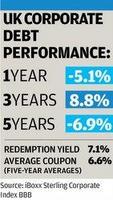In this week’s Investment Blueprint, M&G’s director of fixed income Bernard Abrahamsen says schemes should be looking for safety in their corporate bond allocation
Benign interest rates and economic volatility present UK corporate debt investors with a dilemma. Do they seek safety and wait for opportunity? Or do they dial up risk and chase yield?
In our view, pension schemes with concerns about their funding position and with liabilities to match should be seeking safety and waiting for the value opportunities that must surely follow recession.
This more cautious approach has two elements to it – and neither should mean anaemic returns.
Looking for value
The first element is exposure to senior or secured bonds. Focus on securities sitting higher up an issuer’s capital structure.
In financials, which are so prevalent they make up around half of the average bond index, this means favouring selected asset-backed securities and covered bonds. Bonds such as these offer access to an underlying pool of loans, often prime mortgages.
 Here, investors who can properly analyse the issuer, the bond structure and the underlying security will find that many of these complex and overlooked bonds have offered astonishing value.
Here, investors who can properly analyse the issuer, the bond structure and the underlying security will find that many of these complex and overlooked bonds have offered astonishing value.
At the moment, you can buy a five-year AAA-rated security, with an income derived from a diversified portfolio of prime UK residential mortgage repayments, for a yield of 1.7% above gilts.
This income stream is exceptionally secure because every single mortgage borrower within the bond would have to default on their repayments before an investor faced losses.
Outside of banks, many UK blue chip bond issuers have performed well during the credit crunch. Unlike governments and consumers, few UK companies are overloaded with debt. Many of their bonds have been attractive with, for example, one investment grade Tesco issue offering a yield to maturity (in 2029) of around 4.75%.
The second opportunity is in floating rate assets. Not all of these are included in corporate bond indices and are therefore not always available to investors who track a benchmark or measure active performance against one.
Chief among these are leveraged loans, a market typified by companies issuing loans to finance acquisitions. These can offer an income sitting some 4% above LIBOR, the interest rate at which banks lend to each other, and a place in front of high yield bondholders in the event of default.
This market can offer good protection when official interest rates rise – something we are already seeing in Europe and may well see soon in the UK.
Other floating rate opportunities are in private lending, an area curiously overlooked by many investors.
Private placements – loans made directly to companies, therefore giving the investor opportunity to write their own terms and conditions – commercial real estate mortgage lending, loans to social housing debt and infrastructure debt can all offer an income that ebbs and flows in line with liabilities.
Banks used to lend to these parts of economy in huge volume at cheap levels. After the banking crisis they can no longer do so which means that pension funds willing to provide capital will find they can do so on their own terms. It is a lender’s market.
Time to return to risk?
Pension funds who have done some or all of the above are likely to have been pleased with their UK corporate debt allocations over the past few years. But is it yet time to put heads above the parapet and start buying risk?
It is too early to say but the high yield market is looking increasingly attractive and at this point in the credit cycle I would expect there to emerge a growing number of attractive opportunities at distressed prices. However, investors will only be able to take advantage of them if they have kept their powder dry.
Bernard Abrahamsen is director of fixed income at M&G Investments.






















